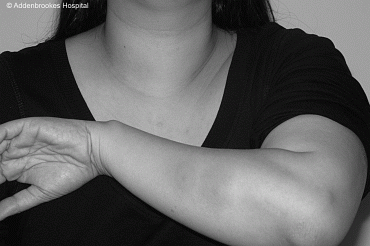SFEBES2012 Poster Presentations Thyroid (52 abstracts)
Fixed drug eruption in the endocrine clinic: rare presentation of reaction to carbimazole
Shwe Zin Chit Pan 1 , Diana Wood 1,2 & Krishna Chatterjee 1,2,3
1Wolfson Diabetes and Endocrine Clinic, Institute of Metabolic science, Addenbrooke's Hospital, Cambridge, United Kingdom; 2Cambridge University, Cambridge, United Kingdom; 3Metabolic Research Laboratories, Cambridge, United Kingdom.
Background: Antithyroid drugs include thioimidazoles (carbimazole, methimazole) and propylthiouracil. Carbimazole is most commonly used in the UK. A fixed drug eruption is the drug-induced cutaneous reaction which occurs at the same site after each exposure to that agent. It is uncommon with anti-thyroid medications. Here we report this rare presentation. A 40-year-old Chinese lady who was diagnosed with Graves’ disease was initially treated with carbimazole, and then with carbimazole and levothyroxine. She developed pruritus and skin changes at 4 months after initiation of carbimazole. She denied fever, arthralgia, arthritis, and pulmonary symptoms which could be features of ANCA- associated vasculitis which is mainly caused by propylthiouracil and rarely thioimidazole. On examination, there was circular macular rash on the forearm with the central part of the lesion being darker. There were no associated oral, eye, or nail or pulmonary involvement. ANCA testing was negative. She was initially managed with antihistamine and self-withdrawal of carbimazole. Initial lesions resolved with residual hyperpigmentation. She then developed recurrence of this rash in the forearm, arm, and shin when Carbimazole was restarted. The rash disappeared when carbimazole was changed to propylthiouracil. Literature analysis reveals upto 50% shared cross reactivity between carbimazole and propylthiouracil. Rash and pruritus are the most common adverse reaction for all thionamides, accounting for 5% of treated patients. However, according to ‘spontaneous reporting of adverse reactions to carbimazole and propylthiouracil in the UK’ through Yellow Card Scheme between 1981 to 2003 (Pearce et al.), rash due to carbimazole is 4th common reported adverse event following neutropenia, hepatobiliary disorder and agranulocytosis.
Conclusion: This case highlights the importance of considerating fixed drug eruption as a rare adverse reaction to carbimazole. Important differential diagnoses for skin lesions in thyroid clinic are allergic reactions, pretibial myxoedema and potentially life threatening ANCA-associated vasculitis.
Declaration of interest: There is no conflict of interest that could be perceived as prejudicing the impartiality of the research reported.
Funding: No specific grant from any funding agency in the public, commercial or not-for-profit sector.





